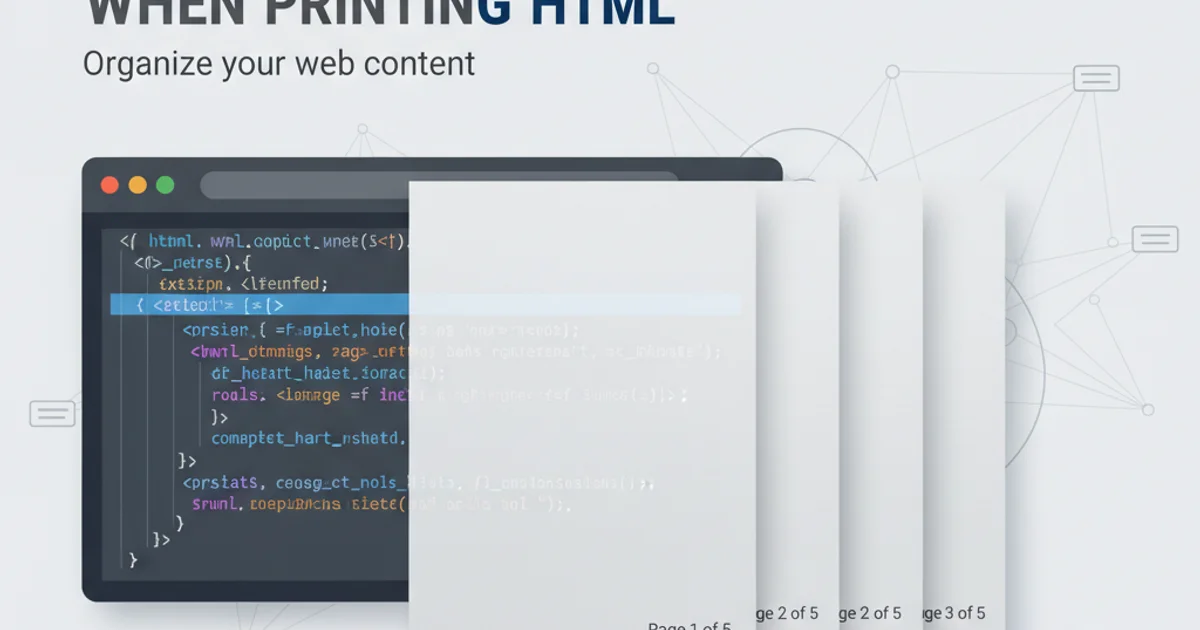Print page numbers on pages when printing HTML
Categories:
Mastering Page Numbers for Printed HTML Documents

Learn how to effectively add and control page numbers when printing web pages using CSS, ensuring professional and organized hard copies.
Printing web pages often presents challenges, especially when it comes to maintaining layout integrity and including essential elements like page numbers. Unlike word processors, browsers don't automatically add page numbers to printed HTML documents. This article will guide you through various CSS techniques to implement reliable page numbering, ensuring your printed web content is professional and easy to navigate.
The @page Rule and CSS Counters
The foundation for printing page numbers in CSS lies with the @page at-rule and CSS counters. The @page rule allows you to define styles specific to printed pages, such as margins, page breaks, and headers/footers. CSS counters, specifically page and pages, are crucial for tracking the current page number and the total number of pages, respectively.
@media print {
@page {
/* Define page margins */
margin: 1cm;
/* Initialize page counter */
counter-increment: page;
/* Add page number to the bottom-right corner */
@bottom-right {
content: "Page " counter(page) " of " counter(pages);
font-size: 10pt;
color: #333;
}
}
}
Basic CSS for adding page numbers using @page and counters.
@media print block. This ensures these styles only apply when the document is being printed, preventing them from affecting the on-screen display.Understanding the Page Numbering Process
The process of generating page numbers involves several steps within the browser's rendering engine. It first calculates the total number of pages, then iterates through each page, incrementing the page counter and displaying the pages counter. This sequence is critical for displaying 'Page X of Y'.
sequenceDiagram
participant Browser
participant CSS Engine
Browser->>CSS Engine: Start Print Job
CSS Engine->>CSS Engine: Calculate Total Pages (counter(pages))
loop For each page
CSS Engine->>CSS Engine: Increment current page (counter-increment: page)
CSS Engine->>Browser: Render Page Content
CSS Engine->>Browser: Render @bottom-right content
end
Browser->>Browser: Output Printed DocumentSequence diagram illustrating the browser's page numbering process.
Advanced Customization and Troubleshooting
While the basic setup works for most cases, you might encounter scenarios where you need more control. For instance, you might want to start numbering from a specific page, or exclude certain sections from page numbering. You can achieve this by resetting counters or using more complex CSS selectors.
Common issues include page numbers not appearing, or appearing incorrectly. This is often due to conflicting CSS rules, incorrect counter initialization, or elements overflowing their containers, which can disrupt the browser's page breaking algorithm. Ensure your body or main content container has overflow: visible; for printing.
@media print {
/* Reset page counter for a specific section */
.no-page-number-section {
counter-reset: page 0;
}
/* Example: Start numbering from 5 for a specific page */
@page:nth-of-type(1) {
counter-set: page 5;
}
/* Ensure content doesn't break page numbering */
body {
overflow: visible !important;
}
}
Advanced CSS for counter control and troubleshooting.
position: fixed or position: absolute elements within your print styles. While useful for headers/footers, they can sometimes interfere with the browser's ability to correctly calculate page breaks and total page counts, leading to unexpected numbering issues.